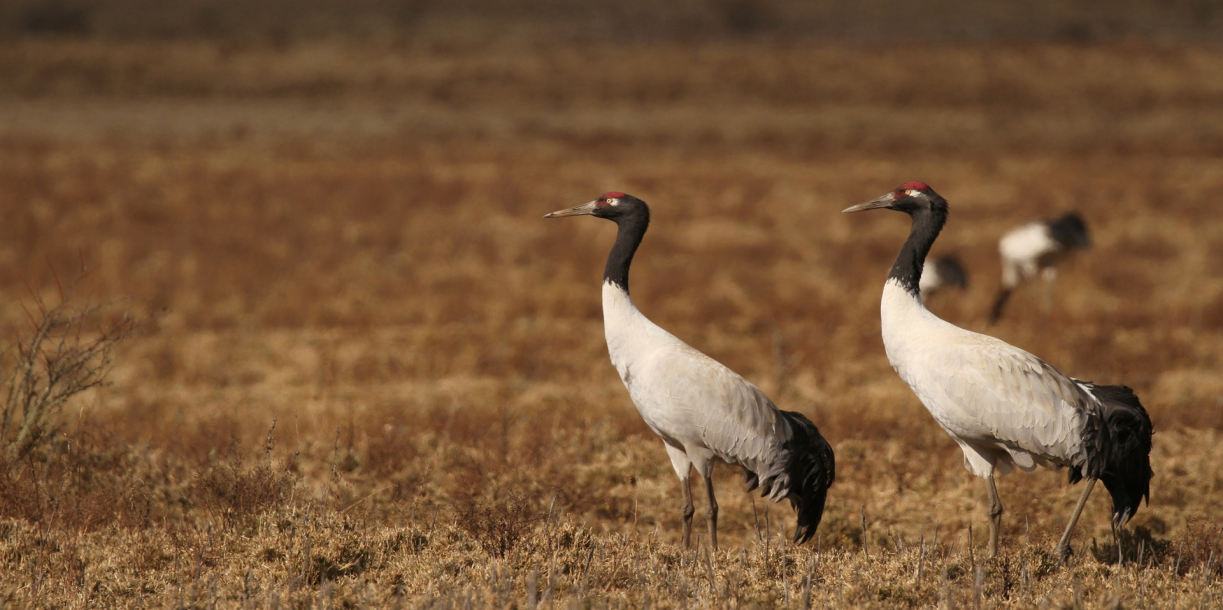Description

Copyright infringement not intended
Picture Courtesy: https://www.andbeyond.com/experiences/asia/bhutan/gangtey/crane-information-centre/
Context: The Wildlife Institute of India (WII) and the Zoological Survey of India (ZSI) have been actively involved in assessing the population and conserving the black-necked cranes in India.
Conservation Measures for Black-necked Cranes in India
Legal Protection
- The black-necked crane is listed in Schedule I of the Wild Life (Protection) Act, 1972, which grants them the highest degree of legal protection in India.
- Additionally, the species is listed in Appendix I of the Convention on International Trade in Endangered Species of Wild Fauna and Flora (CITES) and the Convention on the Conservation of Migratory Species (CMS), providing international recognition and protection.
Protected Areas Designation
- Important habitats of the black-necked crane, such as the Changthang Sanctuary in Ladakh, have been notified as Protected Areas. This designation helps in safeguarding their habitats from human disturbances and development activities.
Ramsar Site Designation
- The Tso Kar Wetlands Complex, which serves as a significant foraging and breeding ground for black-necked cranes, was designated as a Ramsar Site in December 2020. This designation signifies its international importance for wetland conservation.
National Wildlife Action Plan
- The National Wildlife Action Plan (2017-2031) released by the Ministry includes specific chapters and priority actions for the conservation of threatened species, including the black-necked crane, and other aspects of wildlife conservation.
Financial Assistance
- The Central Government provides financial assistance to State/Union Territory Governments under the Centrally Sponsored Scheme 'Development of Wildlife Habitats' for the management of wildlife and its habitat in the country, including habitats of black-necked cranes.
Management Planning Guidelines
- Guidelines for the process of management planning for Protected Areas have been issued by the Ministry under Section 33 of the Wild Life (Protection) Act, 1972. These guidelines help in effective management and conservation planning for protected areas, including habitats of black-necked cranes.
Mission LiFE Programme
- The Government of India has initiated the Mission LiFE (Lifestyle for Environment) programme, aiming to generate public awareness about the environment and conservation, which indirectly benefits the conservation of species like the black-necked crane.
Awareness Initiatives
- Important days such as World Wildlife Day, Wetlands Day, Migratory Bird Day, and Wildlife Week are celebrated to raise awareness about wildlife and biodiversity among the public, contributing to conservation efforts for species like the black-necked crane.

Black-necked Crane
- The black-necked crane, also known as the Tibetan crane, is a captivating bird with a unique appearance and fascinating life cycle.
Appearance
- Standing tall at 135 cm with a 235 cm wingspan, this crane boasts a striking contrast of colours. Its body is a pale greyish-white, while the head, neck, upper legs, and tail are jet black. A vibrant red patch adorns its crown, adding a touch of brilliance.
- Both sexes are similar in appearance, with the male being slightly larger. Juveniles have a brownish head and neck, and their plumage is slightly paler than adults.
Habitat and Distribution
- This crane breeds on the Tibetan Plateau and remote parts of India and Bhutan, typically inhabiting high-altitude lakes, wetlands, and meadows.
- Some populations undertake impressive seasonal migrations, descending to lower altitudes in winter, like Bhutan's Bumdeling Valley, seeking milder temperatures and food sources.
Behaviour and Ecology
- Black-necked cranes live in pairs or small family groups during the breeding season. They are highly social birds, engaging in complex courtship dances involving synchronized leaps, wing-flapping, and calls.
- Their diet consists of various plants, insects, small vertebrates, and aquatic invertebrates, depending on the season and available food sources.
- These vocal birds use a variety of calls, including trumpeting, trumpeting honks, and rattling sounds, to communicate with each other.

Conservation Status
- The black-necked crane is classified as "Vulnerable" by the IUCN. Habitat loss, degradation, and human disturbance pose significant threats to their survival.
- Revered in Buddhist traditions, these cranes are culturally protected in many parts of their range. Festivals and celebrations often honour their presence and symbolize peace and harmony.
|
PRACTICE QUESTION
Q. The IUCN categorizes the Black-Necked Crane as:
A) Critically Endangered
B) Endangered
C) Vulnerable
D) Near Threatened
Answer: C
Explanation:
The IUCN Red List of Threatened Species classifies species based on their risk of extinction, categorized from Least Concern to Extinct.
●Critically Endangered (CR): Extremely high risk of extinction in the wild.
●Endangered (EN): High risk of extinction in the wild.
●Vulnerable (VU): Moderate risk of extinction in the wild.
●Near Threatened (NT): Close to qualifying for Vulnerable status.
●Least Concern (LC): Widespread and abundant with no immediate threat.
As of the latest IUCN assessment in 2023, the Black-Necked Crane is classified as Vulnerable (VU).
|












